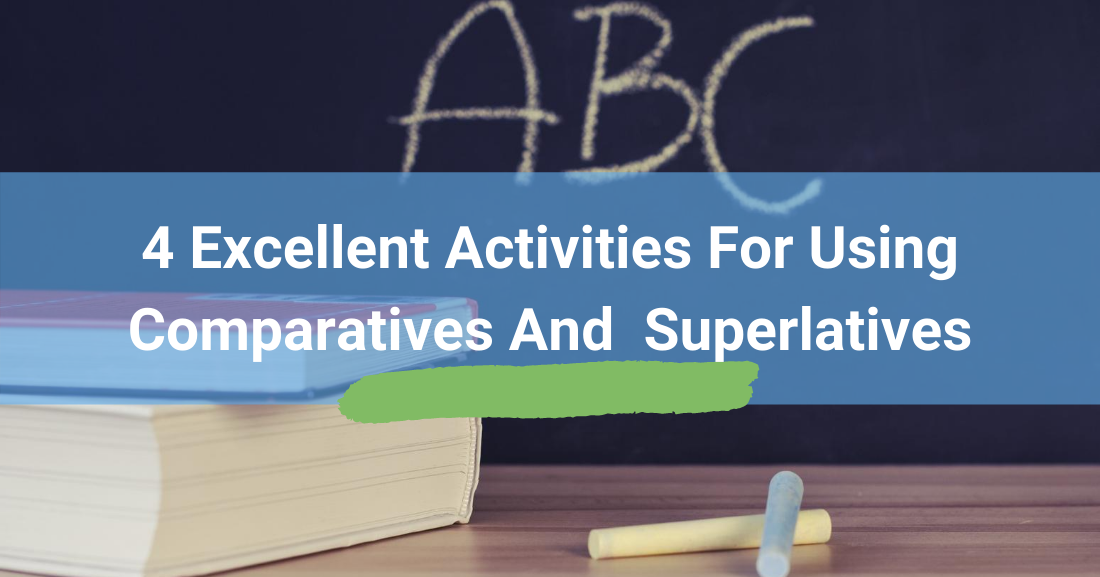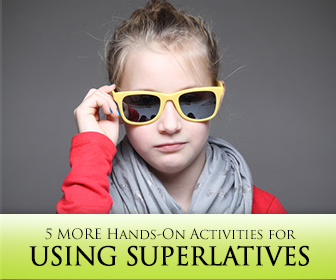7 Excellent Activities for Using Comparatives and Superlatives: The Best and the Brightest


These activities will give them the chance to share their opinions about themselves, their classmates and celebrities all over the world when they name the best and the brightest.

True not many of us will be world famous, but that doesn’t mean we can’t dream that we are. You can let your students imagine a future in which they are award worthy and get practice using superlative adjectives at the same time. Brainstorm with your class various international awards. They might be anything from the Nobel Prize to getting a star on the Hollywood walk of fame. Have each person imagine that they are going to receive one of these awards in their famous future. When they receive the award, the M.C. of the ceremony will give a short speech saying what an amazing person your students are and what they have accomplished in their lifetimes. Have your students write this introductory speech for themselves imagining what they will be well known for in their future. When they do, they should use as many superlative adjectives as possible to show they are worthy of their award. If you like, have each person introduce themselves or their partner during a class award ceremony.
What do a pop singer and an Olympic athlete have in common? Do they have anything in common at all? Get your students thinking about what their favorite celebrities are and aren’t when they assign each one a positive and a negative superlative. Start by having groups of three students gather several pictures of celebrities. They may be sports stars, television personalities, national leaders, or anyone “famous”. Each group should have between ten and fifteen pictures. For each celebrity, the group will write two sentences using superlative adjectives but without using the person’s name. One sentence will be positive. (E.g. This person is the most entertaining singer.) The other will be negative. (E.g. This person is not the most talented chef.) The groups should write each pair of sentences on an index card and, if possible, glue the celebrity’s picture to a separate index card. Once they have finished the sentences, have each group shuffle and exchange their pictures and sentences with another group. The second group will try and match the sentences to the right celebrity.
People say that a dog is man’s best friend, but who among your students has the best pet? This activity gets your ESL students talking about why their pet is best. Your elementary students will love running a campaign for their dogs, cats, etc. for best pet in the classroom. Is their dog the smartest? Can it run the fastest? Is it the cuddliest? Ask each of your students to choose one of their pets (or make one up if they do not have a pet) and write five superlative statements about it. They will display these statements on a campaign poster along with a picture of their pet, but the posters should not say who owns each pet. Arrange the completed posters around your room, and give the class some time to read about their classmates’ pets. After everyone has had a chance to look at the posters, everyone secretly writes down their vote for best pet. Tally the votes and determine the winner. As a prize that person can either bring their pet in for a visit or have the privilege of leaving their poster up for the rest of the week.
Rhythm games are fun for getting students moving and thinking quicklyIn this rhythm game, students will have to offer a superlative for members of your class. Start by arranging your class in a circle sitting on the floor, legs crossed. Then get the rhythm started. Together, the class will clap their hands on their thighs, clap their hands together, snap their fingers and then rest. The entire rhythm should last four beats. Slap, clap, snap, rest. Repeat these motions and keep the rhythm going. Then, have one person say a superlative about someone in the class. On the first beat they should say the person’s name. On the second beat they say “is”. On the last two beats, they give the superlative. For example, Juan (slap) is (clap) smartest (snap and rest). On the next round, they ask someone else in the circle about another member of the class. The first beat is the person who is being asked, the second beat “what’s” and the third beat the person in class being asked about. For example, Lin (slap) what’s (clap) Marie? (snap) Lin would then have to make a superlative about Marie on the next count. (Marie is sweetest. Jorge, what’s Min?) If a student cannot think of a superlative or cannot complete it in the correct beat, he is eliminated from the circle. The game continues until only one person is left.
One of the best parts for students getting their yearbooks at the end of a school year is seeing the superlatives. These awards (best dressed, most likely to succeed, etc.) are given based on student votes. Hold your own superlative votes for the members of your class. Have students decide on the categories or decide on them yourself. Then make up ballots where students will vote for their classmates. On the ballot, list the category and then give space for students to write a sentence. To nominate someone, students write a complete sentence using the superlative. (For example best dressed: Michel is the best dressed.) Collect the ballots and tally the votes. If someone makes a grammatical mistake, their vote does not count. If you have the time and resources, create your own superlative pages with pictures of your students and their awards and make copies for everyone in your class.
Whether it’s the best of the best or the worst of the worst, English speakers encounter superlative adjectives every day. Giving your students a chance to practice them and have fun at the same time will cement the language rule into their minds and put smiles on their faces.